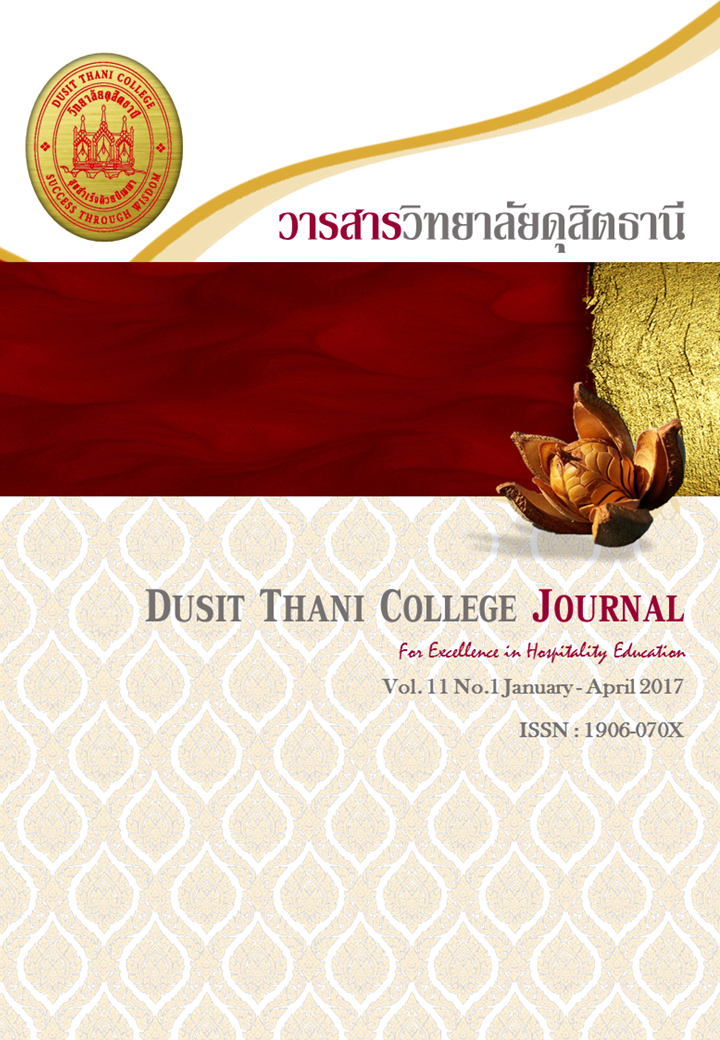Guidelines on Sustainable Tourism Development at The Lakha Community on The Banks of Damnoensaduak Canal in Samutsakhon and Ratchaburi Provinces
Main Article Content
Abstract
The purposes of this research were 1) to study and compare Thai tourists’ behaviors in the community by demographic data 2) to study and compare the marketing mixed factors (7Ps) that tourists in the community focused by the demographic data 3) to study the opinions of the community on cooperation at the tourist destination development 4) to study the opinions of government officials in the community on the sustainable tourist attractions development in the area and 5) to formulate the guidelines on Sustainable Tourism Development that cooperated by the people in the community. The researcher used the mixed method that the questionnaires were collected from 385 Thai tourists in the area at 95% level of confidence. The data analysis based on the descriptive statistics: frequency, percentage, mean and standard deviation and chi-square. The hypothesis testing was done with the Inferential Statistic: t-test, ANOVA and Scheffe method at the 0.05 level of statistical significance. The structured interview was used at 9 key informants in the community.
The result of the research was found that 1) the most visitors travel as the repeaters who received tourism information and advice from their friends. Their trip objectives were relaxing with their family and their travel time is between 8.00 – 11.00 AM and 14.01 – 17.00 PM. The travel expense per head per trip is less than 1,000 baht and most of the tourists used their private cars. The chi-square tests showed that the tourists with different personal factors of age, education and present residence have different travel behaviors. 2) the tourists focused much on Marketing Mix factors as a whole and on factors of personel, place or distribution, process, physical environment, price and product, but only medium emphasis on promotion factor. The hypothesis tested was found that tourists who had different personal factors of age, education and occupation had emphasis on difference factors on the Marketing Mixed Factors. 3) the community emphasises on planning, meeting, and formulating the regulations for the community in tourism. 4) government agencies in the area emphasis on nature conservation and tourist destination development plan formulation including how to maintain the qualities of the environment and the tourist satisfactions and especially spread the benefits throughout the community and 5) The guidelines on the development of the tourism in the area emphasis on the marketing mixed factors that tourists demand and the participation of the people in the community and most of all the government agencies should provide some regulation to preserve the quality of the attractions and services in the community. Furthermore, the budget for public relations and advertising activities should be supported by both the local authorities in the area and government agencies and also private sectors involved.
Article Details
Article Screening Policy
- All research and academic articles to be published must be considered and screened by three peer reviews in the relevant field / article.
- All articles, texts, illustrations and tables published in the journal are the personal opinions of the authors. Editors don't always have to agree. And no responsibility whatsoever is the sole responsibility of the author.
- The articles to be published must never be published. Where did you first publish? And not in the consideration of other journals If the audit found that there has been a duplicate publication It is the sole responsibility of the author.
- Any article that the reader sees as being plagiarized or impersonated without reference. Or mislead the work of the author Please let the journal editor know it will be your greatest blessing.
References
Department of Tourism. (2014). Summary of Tourism Situation in December 2014. (Online). Available from: http://www. m-society.go.th. Cited 30 November 2015.
Jittangwattana, Bunlert. (2005). Sustainable tourism development. 1st Ed.. TAT Academy, Bangkok.
Kangkra, Chanin and Meepleum, Thiti. (2012). Behavior of Visitors in Thailand to Attractions in Petchaburi Province. Degree Bachelor of Business Administration, General Business Management. Silapakorn University.
Kitprdaborisuth, Buntam. (2008). Social Sciences Research Methodology. 10th Ed. Chamchuriproduct Publishing, Bangkok.
Kotler, Philip. (2003). Marketing Management. 11th Ed. Pearson Education.
Kumpet, Kemika. (2012). Guidelines on Sustainable Tourism Development with the Cooperation of Community at Khophayam, Ranong Provinces. Independent study (Tourism and Hotel Management), Naresuan University.
Mongkhonnavakun, Pakcharada. (2012). Satisfaction of Thai tourist toward taling chang floating market. Independent study (Marketing Management), Siam University, Bangkok.
Mongkonvanich, Chonlada. (2013). Youth opinions of the Image of Floating Marketing in Thailand. Journal of Cultural Approach. 14(25), 44-57.
Pathomkanjana, Chaichan. (2014). Guildelines for the Promotion of Cultural Tourism Participation of Community Bangluang, Banglen District, Nakhon Pathom Province. Academic Services Journal Prince of Songkla University. 26(1), 118-129.
Payakvichian, Paradech. (2007). Culture tourism of the community in Thailand. TAT Tourism journal. 4(1), 1-7.
Pongsakornrungsilp, Pimlapas. (2014). The Management of Sustainable Community-Based Tourism: The Case of Ban Kokekrai, Plang Nga Province. Veridinian E-Journal. 7(3), 650-665.
Saenyot, Atinat. (2015). Guideline on the Marketing Development for the Sustainable Tourism at TALAD KO KLOI (KO KLOI MARKET) Amaphoe Muang, Changwat Rayong, Thailand. Independent Study (Hotel and Tourism Management). University of Phayao.
Sereerat, Siriwan. (1998). Marketing Management. Diamond in Business World Publishing, Bangkok.
Silanoi, La-iard, (2015). Sample Size Determination for Survey and Experimental Quantitative Research Design. 1st Ed. Bangkok blueprint Publishing, Bangkok.
Suwankas, Meuanpim. (2010). Floating Market: Requirement of people. (Online). Available from: http://www.lek-prapai.org/watch.php?id=183. Cited 20 October 2015.
Untachai, Subchat. (2012). The Development of Integrated Ecotourism Marketing Management to be Sustainable in Upper Northeastern, Thailand. Udon Thani Rajabhat University.
Uthayan, Chawannuch. (2008). Tourist behavior. (0nline). Available from: http://touristbehavior.wordpress.com. Cited 20 October 2015.
Weiers, Ronald M. (2005). Introduction to Business Statistics. International Student Edition, Fifth Edition, Duxbury Press, Thomson – Brooks/cole, Pennsylvania, USA.
World Tourism Organization. (1998). Guide for Local Authorities on DEVELOPMENT SUSTAINABLE TOURISM. Madrid: Author.


